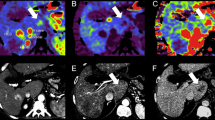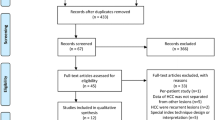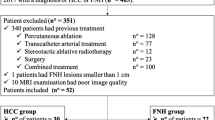Abstract
Aim
To define the prevalence of different multidetector-row computed tomography (MDCT) vascular patterns and their histopathological correlation with liver explants, and to evaluate the accuracy of MDCT for the diagnosis of hepatocellular carcinoma (HCC).
Methods
We retrospectively reviewed 125 cirrhotic patients imaged by MDCT before liver transplantation. Three main vascular patterns were identified: hypervascular lesion with washout (Hyper-L-Wo), hypervascular lesion without washout (Hyper-L) and non-hypervascular lesion (Hypo-L). Radiological findings were matched with histopathology of explants.
Results
Positive predictive value (PPV) and likelihood ratio (LR) were 95% and 18.66, respectively, for Hyper-L-Wo; 45% and 0.82 for Hyper-L; and 75% and 3 for Hypo-L of 20 mm or larger. Overall accuracy of MDCT for detection and characterisation of HCC was 89% and 43%, respectively. Sensitivity of MDCT for detection and characterisation was related to the lesion size, ranging from 78% (lesion smaller than 10 mm) to 98% (larger than 20 mm) and from 9% to 64%, respectively. MDCT established the accurate stage of disease in 46% of the patients, underestimated in 52% and overestimated in 2%.
Conclusion
In cirrhotic patients, any Hyper-L-Wo detected by MDCT can be confidently considered to be HCC. Hyper-L larger than 10 mm and Hypo-L of 20 mm or larger are at high risk of HCC. However, even using MDCT and the newest imaging protocols, imaging underestimated the diagnosis of small HCC.



Similar content being viewed by others
Abbreviations
- MDCT:
-
multidetector-row helical CT
- HCC:
-
hepatocellular carcinoma
- MRN:
-
macroregenerative nodule
- HGDN:
-
high-grade dysplastic nodule
- PPV:
-
positive predictive value
- NPV:
-
negative predictive value
- LR:
-
likelihood ratio
- MELD:
-
model for end-stage liver disease
- UNOS:
-
United Network of Organ Sharing
References
Stigliano R, Burroughs AK (2005) Should we biopsy each liver mass suspicious for HCC before liver transplantation? No, please don’t. J Hepatol 43:563–568
Kojiro M, Nakashima O (1999) Histopathologic evaluation of hepatocellular carcinoma with special reference to small early stage tumors. Semin Liver Dis 19:287–296
Kojiro M (2004) Focus on dysplastic nodules and early hepatocellular carcinoma: an Eastern point of view. Liver Transpl 10(Suppl 1):S3–S8
Forner A, Vilana R, Ayuso C et al (2008) Diagnosis of hepatic nodules 20 mm or smaller in cirrhosis; prospective validation of the noninvasive diagnostic criteria for hepatocellular carcinoma. Hepatology 47:97–104
Bruix J, Sherman M (2005) Management of hepatocellular carcinoma. Hepatology 42:1208–1236
Lopez Hanninen E, Vogl TJ, Bechstein WO et al (1998) Biphasic spiral computed tomography for detection of hepatocellular carcinoma before resection or orthotopic liver transplantation. Invest Radiol 4:216–221
Peterson MS, Baron RL, Marsh JW et al (2000) Pretransplantation surveillance for possible hepatocellular carcinoma in patients with cirrhosis: epidemiology and CT-based tumor detection rate in 430 cases with surgical pathologic correlation. Radiology 217:743–749
Lim JH, Kim CK, Lee WJ et al (2000) Detection of hepatocellular carcinomas and dysplastic nodules in cirrhotic livers: accuracy of helical CT in transplant patients. AJR Am J Roentgenol 175:693–698
Mortele KJ, De Keukeleire K, Praet M et al (2001) Malignant focal hepatic lesions complicating underlying liver disease: dual-phase contrast-enhanced spiral CT sensitivity and specificity in orthotopic liver transplant patients. Eur Radiol 11:1631–1638
Rode A, Bancel B, Douek P et al (2001) Small nodule detection in cirrhotic livers: evaluation with US, spiral CT, and MRI and correlation with pathologic examination of explanted liver. J Comput Assist Tomogr 25:327–336
de Lèdinghen V, David Laharie D, Lecesne R et al (2002) Detection of nodules in liver cirrhosis: spiral computed tomography or magnetic resonance imaging? A prospective study of 88 nodules in 34 patients. Eur J Gastroenterol Hepatol 14:159–165
Zacherl J, Pokieser P, Wrba F et al (2002) Accuracy of multiphasic helical computed tomography and intraoperative sonography in patients undergoing orthotopic liver transplantation for hepatoma: What is the truth? Ann Surg 4:528–532
Freeny PC, Grossholz M, Kaakaji K et al (2003) Significance of hyperattenuating and contrast-enhancing hepatic nodules detected in the cirrhotic liver during arterial phase helical CT in pre-liver transplant patients: radiologic–histopathologic correlation of explanted livers. Abdom Imaging 28:333–346
Burrel M, Llovet JM, Ayuso C et al (2003) MRI angiography is superior to helical CT for detection of HCC prior to liver transplantation: an explant correlation. Hepatology 38:1034–1042
Teefey SA, Hildeboldt CC, Dehdashti F et al (2003) Detection of primary hepatic malignancy in liver transplant candidates: prospective comparison of CT, MR imaging, US, and PET. Radiology 226:533–542
Valls C, Cos M, Figueras J et al (2004) Pretransplantation diagnosis and staging of hepatocellular carcinoma in patients with cirrhosis: value of dual-phase helical CT. AJR Am J Roentgenol 182:1011–1017
Ronzoni A, Artioli D, Scardina R (2007) Role of MDCT in the diagnosis of hepatocellular carcinoma in patients with cirrhosis undergoing orthotopic liver transplantation. AJR Am J Roentgenol 189:792–798
Freeman RB, Mithoefer A, Ruthazer R et al (2006) Optimizing staging for hepatocellular carcinoma before liver transplantation: a retrospective analysis of the UNOS/OPTN database. Liver Transpl 12:1504–1511
Lim JH, Choi D, Kim SH et al (2002) Detection of hepatocellular carcinoma: value of adding delayed phase imaging to dual-phase helical CT. AJR Am J Roentenol 179:67–73
Iannaccone R, Laghi A, Catalano C et al (2005) Hepatocellular carcinoma: role of unenhanced and delayed phase multi-detector row helical CT in patients with cirrhosis. Radiology 234:460–467
Monzawa S, Ichikawa T, Nakajima H et al (2007) Dynamic CT for detecting small hepatocellular carcinoma: usefulness of delayed phase imaging. AJR Am J Roentgenol 188:147–152
Yanaga Y, Awai K, Nakaura T et al (2008) Optimal Contrast dose for depiction of hypervascular hepatocellular carcinoma at dynamic CT using 64-MDCT. AJR Am J Roentgenol 190:1003–1009
International Working Party (1995) Terminology of nodular hepatocellular lesions: International Working Party. Hepatology 22:983–993
Edmondson HA, Steiner PE (1954) Primary carcinoma of the liver. A study of 100 cases among 48900 necropsies. Cancer 7:462–503
Tatsioni A, Zarin DA, Aronson N et al (2005) Challenges in systematic reviews of diagnostic technologies. Ann Intern Med 142:1048–1055
Liver Transplant candidates with hepatocellular carcinoma. United Network for Organ Sharing (UNOS) Policies 3.6.4.4. Available at: http://unos.org/PoliciesandBylaws2/policies/pdfs/policy_8.pdf Accessed 12 July 2009
Jeong YY, Mitchell DG, Kamishima T (2002) Small (≤20 mm) enhancing hepatic nodules seen on arterial phase MR imaging of the cirrhotic liver: clinical implications. AJR Am J Roentgenol 178:1327–1334
Shimizu A, Ito K, Koike S et al (2003) Cirrhosis or chronic hepatitis: evaluation of small (≤2-cm) early-enhancing hepatic lesions with serial contrast-enhanced dynamic MR imaging. Radiology 226:550–555
O’Malley ME, Takayama Y, Sherman M (2005) Outcome of small (10–20 mm) arterial phase-enhancing nodules seen on triphasic liver CT in patients with cirrhosis or chronic liver disease. Am J Gastroenterol 100:1523–1528
Freeny PC, Grossholz M, Kaakaji K et al (2003) Significance of hyperattenuating and contrast-enhancing hepatic nodules detected in the cirrhotic liver during arterial phase helical CT in pre-liver transplant patients: radiologic-histopathologic correlation of explanted livers. Abdom Imaging 8:333–346
Holland AE, Hecht EM, Hahn WY et al (2005) Importance of small (≤20-mm) enhancing lesions seen only during the hepatic arterial phase at MR imaging of the cirrhotic liver: evaluation and comparison with whole explanted liver. Radiology 237:938–944
Bolondi L, Gaiani S, Celli N et al (2005) Characterization of small nodules in cirrhosis by assessment of vascularity: the problem of hypovascular hepatocellular carcinoma. Hepatology 42:27–34
Doyle DJ, O’Malley ME, Jang HJ et al (2007) Value of the unenhanced phase for detection of hepatocellular carcinomas 3 cm or less when performing multiphase computed tomography in patients with cirrhosis. J Comput Assist Tomogr 31:86–92
Author information
Authors and Affiliations
Corresponding author
Additional information
An erratum to this article can be found at http://dx.doi.org/10.1007/s00330-011-2070-1
Rights and permissions
About this article
Cite this article
Luca, A., Caruso, S., Milazzo, M. et al. Multidetector-row computed tomography (MDCT) for the diagnosis of hepatocellular carcinoma in cirrhotic candidates for liver transplantation: prevalence of radiological vascular patterns and histological correlation with liver explants. Eur Radiol 20, 898–907 (2010). https://doi.org/10.1007/s00330-009-1622-0
Received:
Revised:
Accepted:
Published:
Issue Date:
DOI: https://doi.org/10.1007/s00330-009-1622-0




